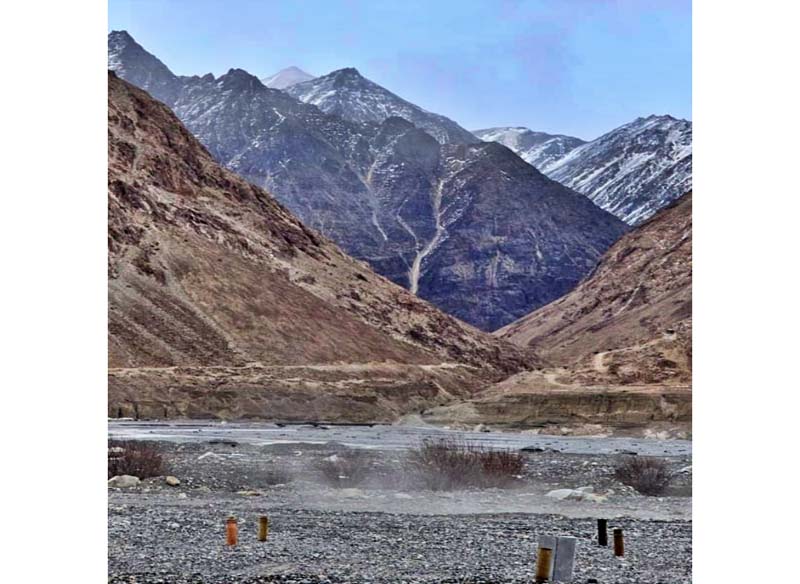JAMMU, Feb 8: As part of the battlefield tourism, the Central Government has opened Demchok located close to the Line of Actual Control (LAC) with China in Eastern Ladakh for tourists while Galwan Valley will be thrown open for the tourists on June 15 this year, the fifth anniversary of martyrdom of 20 Indian soldiers in clash with People’s Liberation Army (PLA) of China which lost its 42 jawans.
The stakeholders in Ladakh have welcomed the Central Government move to promote battlefield tourism saying it will boost the local economy and give a feeling of nationalism to the tourists.
Presently, even the locals can’t visit Galwan Valley where 20 Indian soldiers were martyred after the bloody clash which took place between two Armies after several decades. PLA lost 42 jawans. The clash took place on June 15, 2020.
Officials told the Excelsior that Galwan Valley will be opened for the tourists on June 15, 2025, and in the meantime requisite infrastructure is being generated to promote tourism.
The Ministry of Defence has taken a decision to this effect and the Indian Army is on the board. The Union Territory administration of Ladakh has been briefed about the MoD decision and is making all arrangements for converting Galwan Valley into battlefield tourism.
The Hot Spring area which also falls close to the LAC in Ladakh is also being opened to tourists, with infrastructure development and recce operations already underway.
The move is expected to boost border and rural tourism in the region, providing economic benefits to local communities. From establishing war memorials to commemorate the sacrifices of Indian soldiers to promoting wildlife and cultural tourism, the initiative holds promise for Ladakh’s tourism industry and regional development.
Leh Autonomous Hill Development Council Chairman-cum-CEC Tashi Gyalson told the Excelsior that Government of India’s decision to open Demchok for tourists followed by Galwan Valley and Hot Spring will give boost to tourism and economy and help locals earn their livelihood in better way.
A recce of the Galwan area was conducted on January 19 by a 10-member team of Tourism Enablers representing ALTOA, Taxi Union, Tempo Union, Bike Union, and ALGHA Tourism.
The recce was organized by the GOC Kharu Division and initially, the plan is to open the area to domestic tourists. Pangong Lake attracted a large number of tourists, and the addition of Galwan as a destination is expected to give a significant boost to tourism, the officials said.
Two key infrastructure sites are planned—one at a midway point, 56 kilometers from Durbuk, where a cafeteria, souvenir shop, and accommodation for around 30 people are being built, and another at 120 kilometers from Durbuk. Shayok is the last settlement village along the route; beyond that, there are no further settlements.
A museum is also being developed in Galwan as part of the 2020 memorial. Tourists will have the opportunity to admire the breathtaking landscape.
Meanwhile, Demchok, which was among the two main points of the recent border row with China, has already been opened for civilian visitors as part of the Centre’s new initiative of battlefield tourism, the officials said.
“In high-risk border zones, visitors are required to coordinate with Army units for safety and clearances, facilitated via a single window, while in high-altitude areas, precautions have to be adopted and acclimatization protocols are also being advised,’’ the officials said.
However, entry to certain high-altitude locations will be regulated and special permits can be issued for security purposes. Emergency evacuation protocols by the Army are in place to provide immediate medical assistance, the officials said, adding that weather advisories are issued to prevent mishaps in extreme conditions.
The Army has been working on transforming some of these historic and active battlefields and border areas into accessible tourist destinations. The endeavour allows Indian citizens to explore sites where soldiers have demonstrated exceptional valour, which will also foster a deeper appreciation for the defence forces, they said.
These locations, previously restricted due to their strategic significance and challenging terrains, will now offer visitors firsthand insights into the experiences of soldiers stationed in these remote regions. The move is aimed at promoting connectivity, tourism and socio-economic development in border regions. The Army has been working with local civil authorities to facilitate these efforts while maintaining high operational preparedness.




